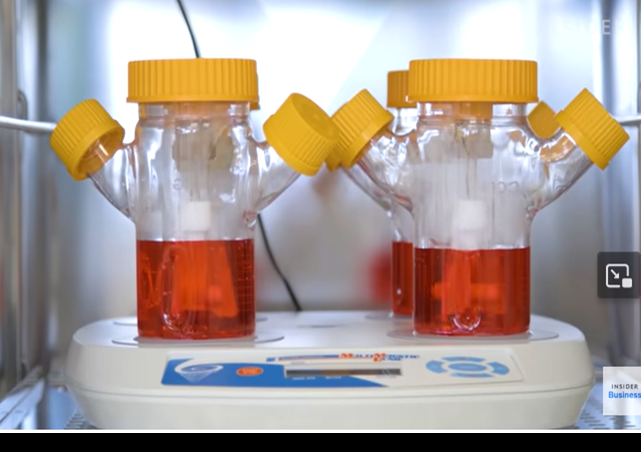Will “Lab Grown Meat” Rebranded as “Cultivated Meat” be an Eco-Business Success?
I have my doubts about the sustainability of “cellular agriculture.”

I have been covering the practicality of marketing meat products grown from laboratory processes, which is being pushed as an alternative to the traditional bovine and poultry protein options that have been deemed “ecocide” by climate change cultists.
This is despite a study concluding that it was up to 25 times worse for the environment than real beef. Despite the potential environmental impacts and lack of technology to safely upscale production to meet consumer needs, the US Department of Agriculture (USDA) has already approved its sale to the public.
Therefore, the introduction to the public of lab-grown meat is being handled similarly to that of green energy technologies.
However, the term “lab-grown meat” seems highly unappetizing, so now it is being rebranded as “cultivated meat.”
The United States is now the second country, after Singapore, to approve the sale of cultivated meat. Cultivated meat is an application of the newest category of animal products: the animal cell itself. Like conventional meat, cultivated meat contains animal muscle, fat, and collagen. This muscle, fat, and collagen, however, are grown directly from animal cells, rather than by raising and slaughtering an animal.
While cultivated meat may hold promise for producing more humane and socially sustainable protein, it may also help solve some of the negative environmental impacts of industrial livestock production. Reducing waste from the meat industry is one area where cultivated meat has tremendous potential, according to CE Delft, an independent consultancy firm.
The cultivated meat comes from “cellular agriculture.” Cell Agriculture Day was recently celebrated at Tufts University, complete with an homage to “sustainability” and “stakeholders,” which are also hallmarks of the green energy technology sales pitch.
Less than six months after gaining federal approval for the sale of lab-grown chicken in the U.S., scientists, investors, government leaders, and other key stakeholders convened for Cellular Agriculture Innovation Day 2024 at Tufts University, the second annual conference dedicated to advancing the consumption of cell-cultured meat.
The atmosphere at Joyce Cummings Center on January 11 was less focused on celebrating wins, however, than on next steps. The immediate goal, according to industry leaders, must be securing additional funding for food-science research as well as increasing consumer confidence in lab-grown meat products. In the longer term, sustainably building out the infrastructure needed to produce cell-cultured meat on a large scale will be essential.
…For Sanah Baig, USDA Deputy Under Secretary for Research, Education, and Economics, these aims align well with the Biden administration’s own “bold goals” plan to reduce global methane emissions from food and agriculture by 30 percent within the decade.
“Global demand for meat is at an all-time high, and protein production will need to be doubled by 2050,” said Baig during welcoming remarks. “You all understand better than most that we simply cannot meet these needs by maintaining our status quo systems. We will need cellular agriculture driving us forward to develop more novel protein sources that use less of our precious natural resources.”
More rational people recognize that cows are important to “sustainability.”
He’s right. Cows are an important part of environmental sustainability. Methane from cows is part of the natural carbon cycle that after 12 years breaks down into natural CO2 and water. Grass absorbs the CO2 by photosynthesis and the cycle starts again.pic.twitter.com/9du9ENJ3Wg
— James Melville
(@JamesMelville) January 21, 2024
And, even if you removed all the cows in the United States and Europe, that wouldn’t touch the millions of methane-generating cud chewers in Africa.
Who says Africa doesn’t contribute to global warming? Of all animals, the (um, how to put this?) biggest emitter of methane gas is the hippopotamus. The largest hippo ever weighed was 10,000 pounds (4536kg), and all are constantly passing gas. pic.twitter.com/KX89tQR8Bl
— James Hall (@hallaboutafrica) September 7, 2019
Meanwhile, an Israeli company has just received approval from health officials to sell the world’s first steaks made from cultivated beef cells.
Aleph Farms, of Rehovot, Israel, was granted the initial go-ahead by the Israeli Health Ministry in December, the company said in a news release. The move was announced late Wednesday by Israeli Prime Minister Benjamin Netanyahu, who called the development “a global breakthrough.”
The firm said it planned to introduce a cultivated “petite steak” to diners in Israel. The beef will be grown from cells derived from a fertilized egg from a Black Angus cow named Lucy living on a California farm.
Researchers are now trying to develop cultivated seafood as well.
Atlantic Fish Co. is in the early stages of production, but aims to create flaky white fish fillets from animal cells to make seafood more sustainable as climate change continues to threaten ocean ecosystems.
“It’s much more ethical and has a much lower carbon footprint, while still providing folks with that real authentic seafood that they know and love,” [Doug Grant is the CEO of Atlantic Fish Co.] said.
While I wish every entrepreneur luck in their endeavor, I suspect there will come a time when investors realize that producing a high-quality protein that tastes delicious and in the most energy-efficient manner comes from the traditional methods used by the ranch and dairy industries.
 DONATE
DONATE
Donations tax deductible
to the full extent allowed by law.









Comments
You mean the earthworm protein that McDonalds was accused of using instead of beef wasn’t good enough? (“4 billion served and still on the first cow).
Does “cultivated meat” taste as good as pink slime?
Soylent Green tastes too much like pork.
Not a fan of long pig myself.
It might taste better if made from “stakeholders”, or is it “steakholders”.
This is what they so-called self-appointed elites are wanting as their end game, they read the book and “Hey, good idea!”. This will not end well…for them.
“Cultivated meat” is essentially cancer meat. Does that sound appetizing?
And I say this as a cow. The curse of my bovine herd are we are so darn delicious.
Reminds me of Bill Cosby and the giant chicken heart that ate New York.
Chickenheart! That was great.
I am going to guess hippo might be really good. I knew someone who tried dugong and said it was better than prime rib.
I’m sorry, I do not wish them well. I hope they all go under.
Don’t be sorrry, they would not be anywhere near that courteous.
“socially sustainable” … LOL. That’s so retarded it’s funny.
So says the people who have gotten us to the point of people defecating in the street as part of the normal day … They’re really worried about “reducing waste”.
They’ll probably have a hit. When I was in Israel the beef was so awful that most of it was just inedible. It was gross. And that wasn’t because of kashrut – I’ve had lots of good kosher meat here. It was just bad, awful meat. 97% of it. I almost gave up eating meat there until I found one decent butcher. I would never order meat at the restaurants, no matter how high class and expensive they were. NEVER.
“Socially Sustainable” is Orwellian language for “Affirms the fever-dreams of a mentally ill Swedish teenage girl who has been granted control of the left’s global energy policy”
The left. Yes, they are that retarded.
“Will the world’s wealthy elite continue their war on the peasantry?”
Until the day we get tired of it, and remove them.
I can already imagine the conspiracy theory hysteria regarding Israeli companies growing lab meat propagating through muslim majority countries and Europe.
Also mainland China and wet market lab meat. We can totally trust the CCP to do the wrong thing with the tech.
No mention of cost per pound. How about starting with hotdogs? Then work your way up beef steaks..
“Increasing consumer confidence”
Oh, goody, we’ll be subjected to unceasing NGO propaganda campaigns.
I’m far more concerned with the nutritional value of these products than I am their ‘carbon footprint’…or ANY food’s carbon footprint. What is inescapable is MEAT is an essential element for the developing human brain. Adolescents need ample access to complex proteins that are only available in – you guess it – actual meat. There’s a reason why cultures that developed farming and animal husbandry developed at a much faster pace than cultures that did not. ANIMAL PROTEIN is the reason.
The question will be if this ‘cultivated meat’ will be nutritionally identical to actual meat. I suspect it will not. I do suspect that just like the Impossible burger, it will be PACKED with sodium, though.
There were some analyses done of the nutrient values of the different commercially available products back in 2021-2022. Those products were inferior to good, regular old fashioned hoof, feather and fin sources. Especially missing were sufficient quantities of the specific essential amino acids like methionine and lysine, for example.
Not to mention, just YECCCCCH….lab grown meat….
Hindering development of the human brain might be a “feature” not a “bug” of the product. Or course, products made from bugs are also under consideration.
In principle this should be exactly identical to regular meat.
Obama’s holding out until they start working with dog cells.
You’ll know it’s a done deal when Pierre Delecto is delivering dog meat to Obama’s hacienda. You’ll be able to recognize the cages on his auto rooftop.
No….Lab Meat is stupid and the market has spoken. Make it stop.
This is yet another attempt to wreck our ranchers livelihoods by some government interference backdoor. Find out where the money came from; Gates, etc. in bed with The Swamp. No different than with EV’s, Windmill and Solar grid power, education, energy…on and on the subversive Merry-Go-Round we (them) go.
It’s funny how big agriculture can manufacture processed meat from cells with no idea of the long term damages, but little Amish farms cannot sell raw milk and egg nog that hasn’t been pasteurized.
I would rather consume something that has a low risk of contamination, than a lab grown whatever without long term studies.
Another one of those things I’m old enough to remember that will soon pass into history was the milkman delivering our milk every morning, fresh from the farm. In the winter, if you didn’t get out to bring it in soon enough, the cream at the top would freeze and lift the cap up an inch.
Lab grown meat? YECHHH! I remember reading the nutritional analyses of the commercially available products which concluded that it did not contain enough nutrients to be equivalent to regular, good old-fashioned meats.
I’ll take the real thing, thank you!
Lab Meat: 42 ingredients, mostly chemicals & spices.
Beef or Chicken: 1 each, beef or chicken.
Nuf said.
Well, there is the issue of loads of steroids…
Buy from Good Ranchers or your local rancher/farmer, bypass the huge corporate producers and packing houses, besides the fact they’ve gone off the rails with being in bed with Big Brother, who effectively own them.
I live near a large Amish population. My wife and I already purchase many items, including meat, ice cream, and vegetables from them.
I usually buy local, and avoid the big box stores, to include Cost-Too-Much, Home Improvement, and Wally-World.
There aren’t any commercially available products. This whole technology is still in the development stage. It’s just coming to market now, so you couldn’t possibly have seen any analysis of it.
We’ve seen what happens when things are grown in labs – think Covid. And we know what happens when governments, NGOs and otherwise bad actors influence industries (and media and finance). Once our food becomes manufactured to a standard and controlled think how easily a drug or other agent of harm or control could be inserted into that food supply. No thanks.
Ugh, more frankenfoods … hard pass
Will I be eating that chemical slop? A clue: No!
“The immediate goal, according to industry leaders, must be securing additional funding for food-science research as well as increasing consumer confidence in lab-grown meat products.”
If this is such a good idea, then BIG AG can fund it themselves.
BIG AUTO bought into EV production because BIG GOV subsidies manufacturing and sales.
All of these need to stand on their own feet, and if they can’t, then buh bye.
If you want to splurge on some expensive but incredibly delicious beef, I highly recommend this ranch: https://2fakaushibeef.com
…laboratory grown “meat”.
A whole new meaning for “mystery meat”
I’m shocked they didn’t decide on using “Craft Meat”. Heck, Wendy’s uses the term Craft Lemonade with their custom lemonade offerings. Appeal to the hip Z’s.
No thank you on vat, cultivated, craft, or faux meat. I’ll take my beef from the Cow.
Consumers will decide if there’s a viable market for lab-grown meat. As long as the bill for R&D and marketing is being footed by private sector investors, not taxpayers, I don’t have an issue with it.
When the USDA got involved, you can bet that we the taxpayer are already footing the bill. Not to mention the federal research grants to Tufts.
“For Sanah Baig, USDA Deputy Under Secretary for Research, Education, and Economics, these aims align well with the Biden administration’s own “bold goals” plan to reduce global methane emissions from food and agriculture by 30 percent within the decade.
“Global demand for meat is at an all-time high, and protein production will need to be doubled by 2050,” said Baig during welcoming remarks. “You all understand better than most that we simply cannot meet these needs by maintaining our status quo systems.”
Well, I definitely don’t support the grants that you describe. This should be a private sector-funded enterprise, exclusively.
Answer to headline question ; NO!
Not “Lab Grown Meat.”
More like “Lav Grown Meat” -As in “Lavatory Grown Meat.”
I could see a niche market for those that like everything scientifically measured to the nth degree. Controlling the proportions of all macros and micros could appeal to some.
However, this is definitely NOT going to be environmentally friendly. A first year lab tech on a cell culture bench could tell you that. The ratio of input:yield is way too low.
I’m not sure some people are fully aware of how much more resource and time intensive it is to keep a dish of dissociated cells alive than it is to keep a unified organism made of cells alive.
This clip from a short lived TV show about a company that was definitely not GE called Better Off Ted
https://www.youtube.com/watch?v=tGlM6jGUSoA
I’m going to keep shooting deer. They’re cultivated on the food plots we plant each year.
Are the rich and powerful going to be eating this stuff?
No? Then neither will the plebs. They will want real steak from real cattle.
Maybe these “lab-grown meat” businesses can partner up with “gender-affirming surgery” clinics.
I mean, they’re both in the fake meat business…
FJB
Lab meat looks way better when you leave out the inputs. Kinda like EVs. Tell me again how environmentally controlled petri dishes are easier to maintain than cows? Easier inputs? Now let’s talk about the other end — how’s that wind rotor disposal working out?
Buffalo — American Bison — bulk up plenty eating thistles out in the weather. A couple white tail deer makes a season’s worth of freezer meat for a family. Bonus, foraging generates better macro and micro-nutrient profiles. And in some situations ruminant forging can transform n recover entire ecologies.
(Grazing destruction reportage with plaintive music under carefully shot vistas always shows *over-grazing.* Definitionally it’s abuse, causing harm.)
You’d think the “eat more bugs” people would get this. Or maybe it’s not actually about more, better nutrition with less impact.
… nevermind.